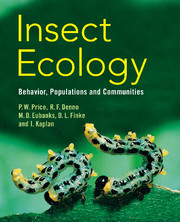Book contents
- Frontmatter
- Contents
- Preface
- Acknowledgments
- Part I Introduction
- Part II Behavioral ecology
- Part III Species interactions
- Part IV Population ecology
- 9 Demography, population growth and life tables
- 10 Life histories
- 11 Population dynamics
- Part V Food webs and communities
- Part VI Broad patterns in nature
- Glossary
- References
- Author Index
- Taxonomic Index
- Subject Index
- Plate section
- References
10 - Life histories
from Part IV - Population ecology
Published online by Cambridge University Press: 05 June 2012
- Frontmatter
- Contents
- Preface
- Acknowledgments
- Part I Introduction
- Part II Behavioral ecology
- Part III Species interactions
- Part IV Population ecology
- 9 Demography, population growth and life tables
- 10 Life histories
- 11 Population dynamics
- Part V Food webs and communities
- Part VI Broad patterns in nature
- Glossary
- References
- Author Index
- Taxonomic Index
- Subject Index
- Plate section
- References
Summary
The study of life histories involves the full span of life, from egg or sperm through reproduction and death. The ways in which individuals maximize progeny production and survival are about as diverse as the populations and species themselves. Research interest in life history is therefore strongly comparative, looking at the variation in life-history characteristics within populations, within species and among related species. As with ecology in general, we search for patterns in nature and develop hypotheses and theories, which account for the trends that we observe, and prompt new observations in a cycle of efforts to refine knowledge.
Understanding of life histories is fundamental to insect ecology, and we have covered many examples of life-history studies already in this book, and more will follow. Behavioral traits that promote fitness were covered in Chapter 2, and the evolution of life histories of social insects was discussed in Chapter 3. Chapter 4 included discussion of wing polymorphism in planthoppers (Figure 4.5), and jousting and territoriality of Pemphigus aphids (Figure 4.11). Density effects on planthopper fecundity and wing polymorphism were involved with competition (Chapter 5, Figure 5.8), and egg-laying schedules of a fruit fly were described in Chapter 9 (Figure 9.10). We noted also in Chapter 9 the differences between pro-ovigenic and synovigenic egg production, and the marked differences in survival of progeny portrayed in survivorship curves. In Chapter 6 different strategies of yucca moths were noted among true pollinators and two classes of cheaters (Figure 6.14). We also saw divergence of life-history types in scarab beetles (Figure 6.16) and the constraints on ovariole number and fecundity of parasitoid wasps and flies (Figure 8.4). Indeed, the study of life-history traits runs throughout ecology, and this is how it should be, because understanding the evolution of whole life histories is at the heart of understanding insects, and the evolutionary pathways along which they have traveled. This point is taken up again in the last section of this chapter on applications.
- Type
- Chapter
- Information
- Insect EcologyBehavior, Populations and Communities, pp. 373 - 403Publisher: Cambridge University PressPrint publication year: 2011

